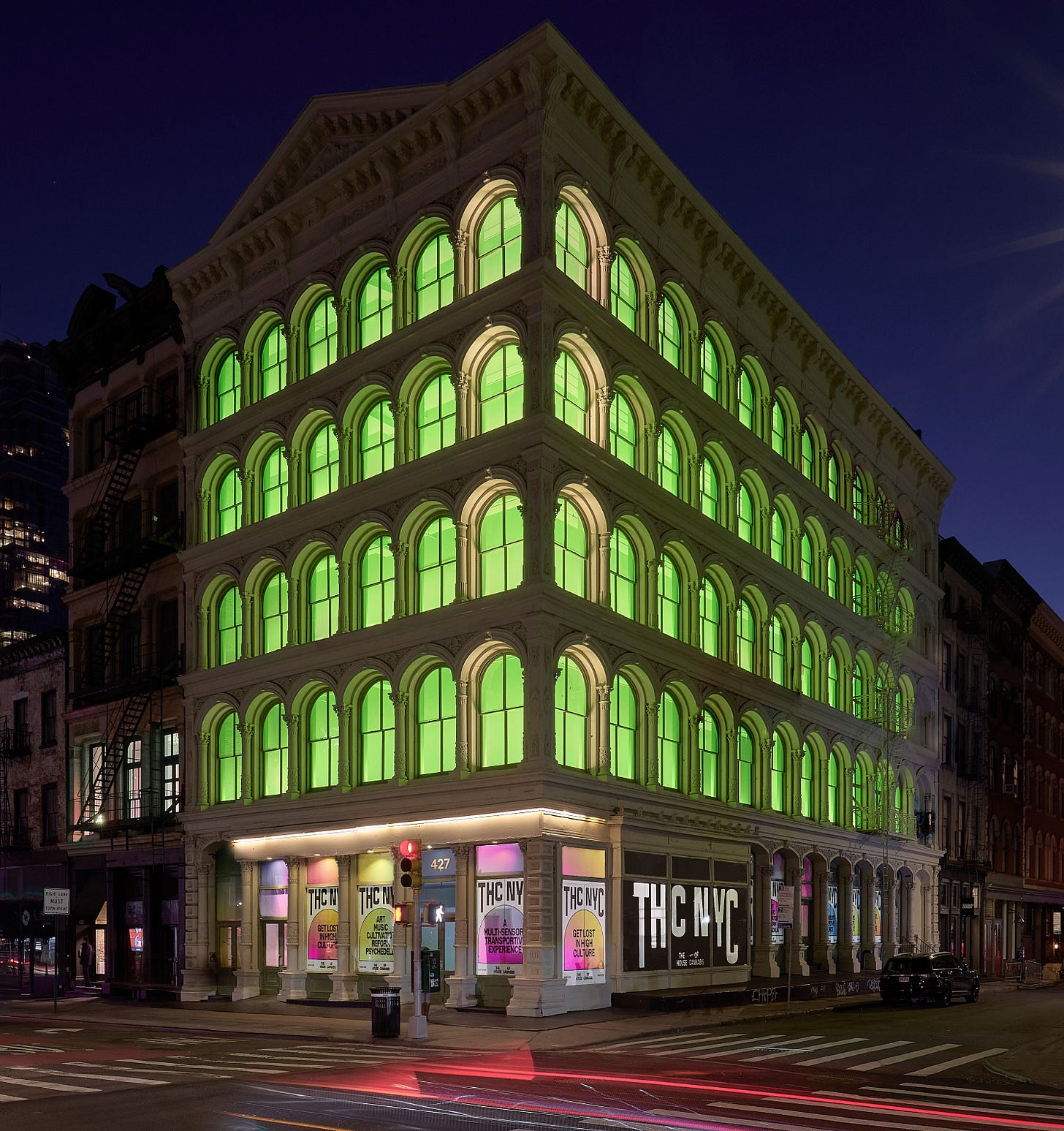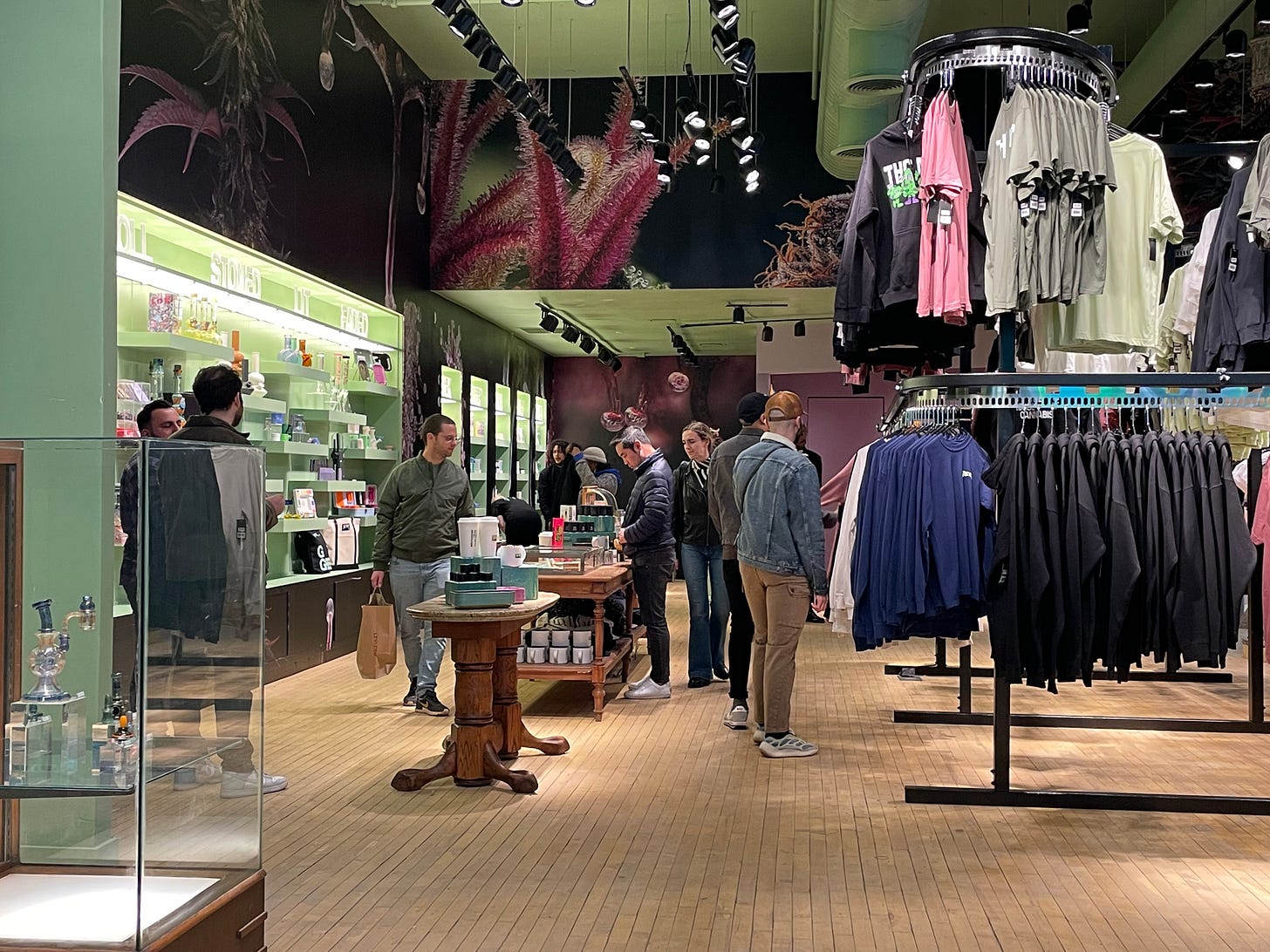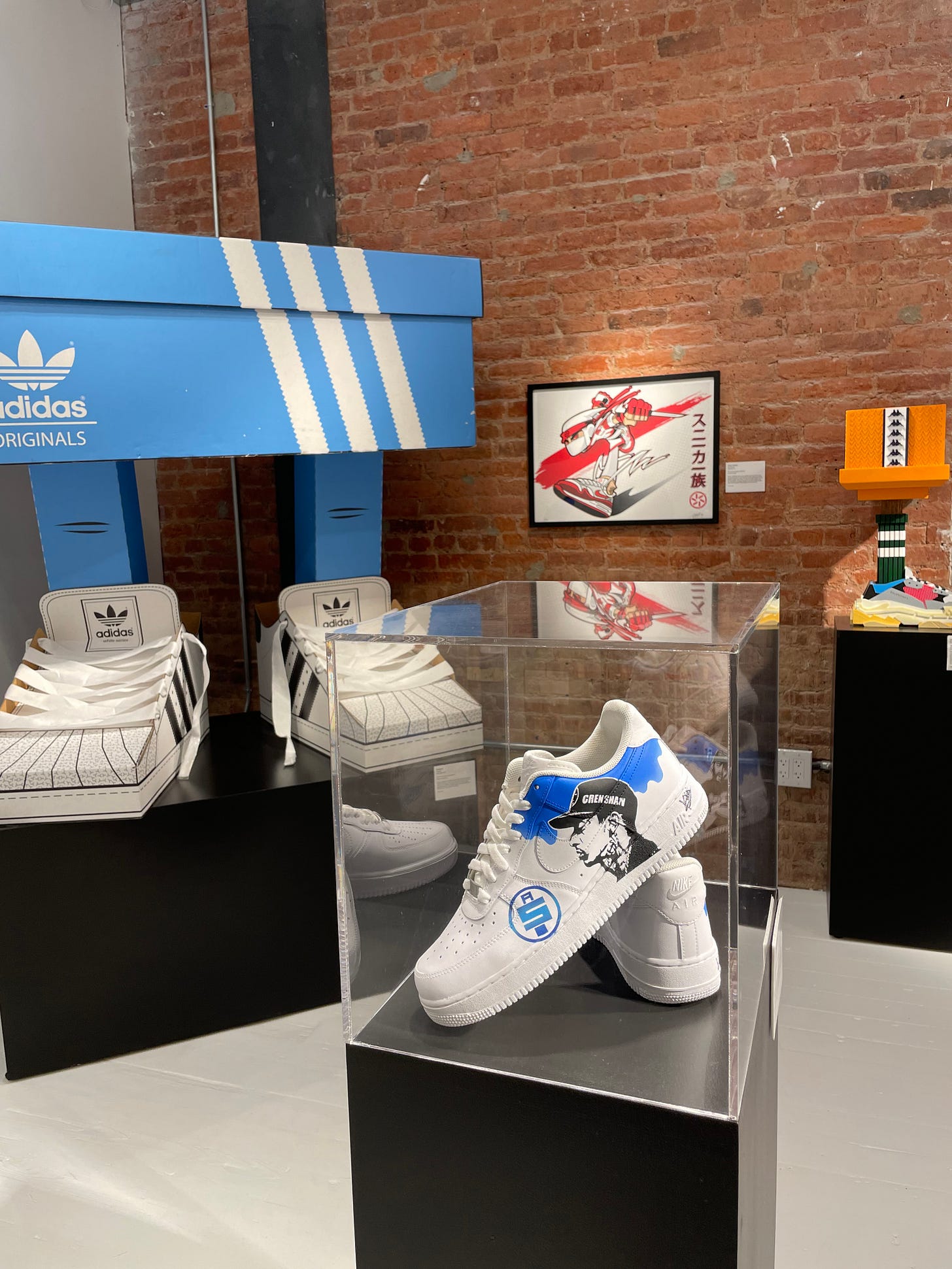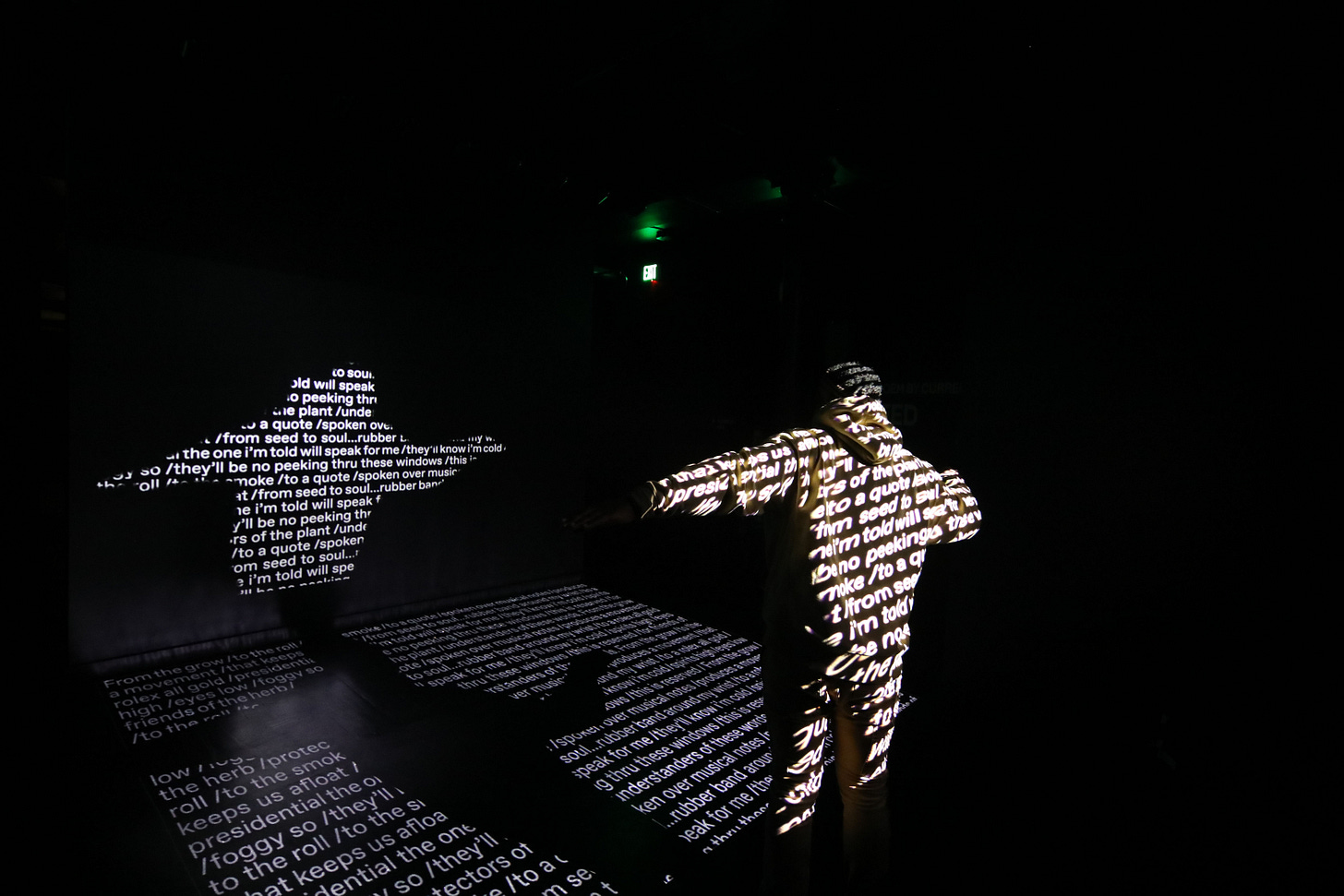I Went to The House of Cannabis Museum and All I Got Was High
Ripping through the newest NYC experiential destination for stoners
If you caught last week’s interview with House of Puff’s founder and CEO Kristina Lopez Adduci, you might have picked up on a little tidbit: New York just got its first weed museum, THC NYC a.k.a. The House of Cannabis.
Following in the footsteps of the Museum of Ice Cream, Artechhouse, and Museum of Illusions, The House of Cannabis is an experiential museum designed for sensory immersion centered around the plant we all know and love. Last Friday, I decided to check out the grand opening. Let’s go inside!
Popping an edible, I took a leisurely stroll to the five-story museum in SoHo where I was greeted with an enormous bong cementing the sprawling retail space that will eventually feature live glassblowing and host large-scale events, according to Tiffany Kary’s report on Bloomberg. The $15 million 10-year lease on the 30,000-square-foot building also marks one of the largest real estate deals of the year, so you can expect many hands contributing.
The retail at House of Cannabis is definitely among its best features, where you can stock up on cool papers from Field Trip, Blazy Susan, and House of Puff, as well as legendary standbys Abadie and OCB. There were also nice pieces from makers like Yew Yew, Edie Parker, Summerland and Studenglass, branded apparel and lifestyle accessories featured in their online store, plus a decent selection of niche snacks (though, the check out process between these two areas was messy, much to the consternation of both myself and the employees).
In fact, I was excited to see that most of the retail items featured at past Luxury Meets Cannabis Conferences finally in one place. I’d definitely rate this among the best museum gift shops in New York City next to the Museum of Sex, MoMa Design Store, and the Tenement Museum. Still, even though I had taken an edible, I can tell you right away that the weirdest thing about the museum wasn’t the cannabis.
So, what do you get? A lot of Instagram opportunities!
Each guided tour begins with ambitiously ushering guests up four flights of stairs (an underrated truly authentic New York experience), ascending towards a purple neon sign that says “Go Higher.” It actually kind of reminds me of this daily walk I used to have to take when I was studying at Charles University in Prague where I had to trek uphill for about 15 minutes while chain smoking Gauloises right after downing my requisite “between class beer” before hauling up another three of flights of stairs towards a giant cross at the base of the neo-Gothic basilica within the fortified castle of Vyšehrad—except maybe a little less oppressive. Maybe that point of reference doesn’t work for you, but trust me: it’s about as high to heaven as Dolly Parton’s hair.
Watching everyone huff and puff their way to the top, I couldn’t help but wonder if the property is ADA accessible (it is). And to the credit of the staff, they also checked in with all guests beforehand about light sensitivities and disabilities to help accommodate. That said, it’s recommended that you wear comfortable shoes because it’s a real shlep and a half.
After going through a hall of mirrors, we enter the Disorientation Room: an intimate all-white theater inspired by the artist James Turrell saturated in neon green light. As the program started, the room began to flash different colors before projecting a film blasting a collage of various pop culture media from Jimi Hendrix playing at Woodstock to Snoop Dogg, Martha, and the War on Drugs to illustrate the contemporary cultural impact of cannabis through what felt like a very, very expensive sound system. As a stoned person, this was undeniably enjoyable.
Next up: the tour group is whisked into The Euphorium, a dimly lit room anchored by an enormous turntable. Each guest is given a pair of high quality headphones and invited to lay on the turntable that spins around with a dazzling coordinated light show created by concert and fashion lighting designer, Nitemind’s Michael Potvin (Public Records, Paragon SavagexFenty, Saint Laurent, LaQuan Smith) while listening to a mash-up of weed hits from The Doors and Afroman to DRAM’s “Broccoli.”
Again, as a stoned person, this was great. Someone else on the tour told me they don’t use weed* but still thought it was very cool, so this attraction seems like a win for users and non-users alike. Actually, now that I think about it, I was surprised that I was the only stoned person on the tour, unless everyone was as good at hiding it as I am.
*I was surprised this person wasn’t a user considering they were shoving snacks into their face even before we entered the exhibit—a telltale sign of someone with uncontrollable munchies—but who am I to judge someone the need to feed? I also took a very good photo of them because that’s what this museum is for.
Still, for an experience that is all about substances, it was strangely lacking in that area. Instead, it’s all about style, which makes sense since the founders are Robert and Marcelle Frey—a Las Vegas nightlife impresario and retail designer. Robert tells Bloomberg, “We’re educational, we focus on music, art, film, science — you don’t see that in a nightclub” but the actual experience says differently. Given the complexity of science, politics, history and culture of this divisive plant, I was surprised to walk away learning very little about…anything, really. Then again, I don’t know about you, but I’ve never gone to Vegas in search of intellectual development.
While it claims to touch on 6,000 years of history, that seems to be generous for what you actually get. I didn’t quite understand why The House of Cannabis decided to chop the history of the plant in half from its 12,000-year global history rooted in Central Asia and expansion into Africa, Europe and the Americas; skipping over the presence in religious texts and Greco-Roman mythology; the foundation of hemp within colonialist America and seed sales among the Shakers; its cultural impact as part of pre-Prohibition; what cannabis culture means in different parts of the world; and most obviously: the absence of women, queer people, and medical users.
That last one was probably the worst omission that I hope they address and integrate within the permanent exhibition instead of some token rotating exhibit for Women’s History Month or Pride Month. The cannabis exhibit last year at the Yivo Institute also completely erased women, but at least whatever you got was undeniably well-researched and interesting.
You won’t learn about how the "Sticky Brownies" empire helped San Francisco's first LGBTQ+ medical patients during the AIDS crisis or why Charlotte Figi is so essential to the CBD movement. There’s nothing on Jack Herer or most of the players from his generation, nor is there anything on the tremendous hurdles Rick Simpson had to deal with in order to help others access plant medicine to heal themselves from cancer. In fact, you don’t really learn about anyone aside from the audio-visual cameos alluding to pop culture figures. But who cares when the playlist is so sick?
Arguably, these could be future exhibits, but even from a pop culture perspective, there’s limited information about how these disparate elements of music, art, film, science and fashion are intertwined with cannabis. Nearly everything exists as a visual or audio cultural point of reference given that this is experiential in nature, somehow assuming the consumer knows everything and nothing at the same time. It dumbs down everything to make it approachable, yet somehow doesn’t even explain the most basic terminology and differences between marijuana, hemp, THC, or CBD.
The Grow Room, for example, provides a rare opportunity to wander though a cannabis cultivation lab and see actual plants throughout the growth process (including a glimpse of how much energy is wasted on indoor farming if you’re savvy enough to catch that), but doesn’t list the strains, science, or history behind some of the most important cultivars around the world. I asked the guy standing in the room for however many hours per day what was growing and he had no idea. Nor did the person leading the tour. That wasn’t a hardball question, and frankly it should have been listed. The Microverse showcases stunning microscopic photography from Kandid Kush—among the most incredible Instagram-worthy rooms that looks like a galactic princess fantasy film. But want to know what a trichrome actually is? You won’t find that information in the museum.
Even The Joint—a rotating gallery space “honoring artists and makers at the nexus of cannabis culture from the worlds of fashion, music and art”—features an exhibit on The Art of Sneakers. While this is surely a draw to the sneakerheads and everything looks cool, it just doesn’t really create a visible tie to cannabis. Instead, it just reinforces the capitalistic emptiness of brands and superficial status symbols. But I guess this is the culture we live in now.
The most information-heavy room in the museum is the Social Justice room. Partnering with the Drug Policy Alliance, visitors can learn about the impact of the War on Drugs that persists today with issues on family regulation, education, immigration, employment*, and housing, and touches on New York State’s Marijuana Regulation and Taxation Act (MRTA).
It also features powerful interviews with formerly incarcerated people across five large screens, directed by Christian Padron and produced by Scheme Engine, a prominent BIPOC owned agency, which I thought was actually a very thoughtful and meaningful way of presenting lived stories. Interestingly, the five interviews included three black women, one white man, and one black man who was the only one shielded for anonymity. Not sure why they did it that way, but it was noticeably among the few places highlighting women that were not used as visual props or selling me something.
*Note: the museum worked with A Second U Foundation to source 20 percent of its workforce, who were formerly incarcerated.
After having more photos of myself taken throughout The Grow and Microverse, I entered the Olfactory: a space dedicated to demystifying terpenes. I liked this space a lot, as it offered an opportunity to identify different aromas and connect them to the sensory experience (e.g. the impact of pinene and myrcene on creativity). At the same time, you only kind of understand it. I did thoroughly enjoy the essential oil aromatherapy though.
To cap off the exhibit, rapper Curren$y contributed an interactive poem called Seed To Soul. I guess the idea is that your body is supposed to illuminate certain portions of the text, but the interaction prevents you from reading any of it. As a writer, I found this to be super frustrating and incoherent. Here’s what mine said:
/prod
wrist/
cold/sp
s reserve
ords. From the
/produces a mov
my wrist /to a role
i’m cold/spirits hig
is reserved/Fro
otes/produces
my wrist/to a
i’m cold/spiri
/this is reserved/
words. From the
produces a m
wrist/to a
i’m cold/s
is reserve
I was directed to back up really far with my arms extended so it would illuminate the whole thing, but that honestly didn’t offer any more clarity which is unfortunate because I had no idea what it was trying to say.
As I headed down alone, I wasn’t sure if I was allowed to enter the second floor. The museum seemed a little understaffed and the door was closed, so I missed out on The Spot and Hypnodrome, an audio-visual experience developed by visual artist Benjamin Gordon that is supposed to make you feel the effects of cannabis without consuming it. But at that point, I could have taken or left it. I stocked up some papers and a prebiotic soda then bounced.
And that’s what you get. Was it fun? Sure. Was it fun enough for $45 after fees? Not really. Then again, plenty of people pay this much for other AI-related entertainment experiences that I would never waste my money on. And as New York’s legal landscape continues to grow, this is essentially the future: large-scale investments with a careless erasure of cultural history if it doesn’t fit within a marketable aesthetic. Honestly, I really wanted to love it and hoping they use this feedback to improve their programming. To that point, I would 100% go back to shop at the retail store but the bottom line is that if you’re looking for genuine education on cannabis, you’re not really going to find it here.
Coming soon to the Pipe Dreams newsletter and podcast:
Consumption Lounge 420 Extravaganza!
Chatting with Lex Corwin of Stone Road Farms
Welcome to the The Weed Witch coven. If you liked this post, click the heart button below and consider upgrading to a paid subscription. Fall down the wrong rabbit hole? Click here to unsubscribe.











